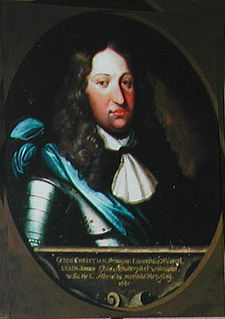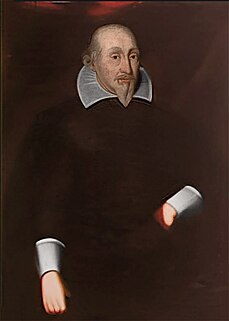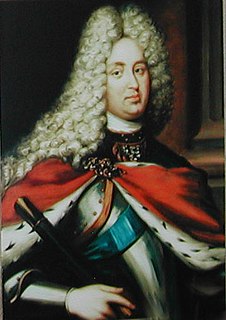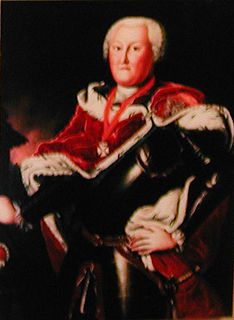Life
Enno Louis grew up in the Netherlands, France and Switzerland and had an expensive education. At the age of 19 he was appointed Reichshofrat on the court of emperor Ferdinand III. With this the emperor recognised his maturity and governing skills. So he could push aside his mother Juliana of Hesse-Darmstadt and her advisers from the government. In 1651 he became count of East Frisia. Quickly after this he tried and executed the favourite and lover of his mother, the geheimrat Johann von Marenholz. He was executed in Wittmund on July 21, 1651.

The Netherlands is a country located mainly in Northwestern Europe. The European portion of the Netherlands consists of twelve separate provinces that border Germany to the east, Belgium to the south, and the North Sea to the northwest, with maritime borders in the North Sea with Belgium, Germany and the United Kingdom. Together with three island territories in the Caribbean Sea—Bonaire, Sint Eustatius and Saba— it forms a constituent country of the Kingdom of the Netherlands. The official language is Dutch, but a secondary official language in the province of Friesland is West Frisian.

France, officially the French Republic, is a country whose territory consists of metropolitan France in Western Europe and several overseas regions and territories. The metropolitan area of France extends from the Mediterranean Sea to the English Channel and the North Sea, and from the Rhine to the Atlantic Ocean. It is bordered by Belgium, Luxembourg and Germany to the northeast, Switzerland and Italy to the east, and Andorra and Spain to the south. The overseas territories include French Guiana in South America and several islands in the Atlantic, Pacific and Indian oceans. The country's 18 integral regions span a combined area of 643,801 square kilometres (248,573 sq mi) and a total population of 67.3 million. France, a sovereign state, is a unitary semi-presidential republic with its capital in Paris, the country's largest city and main cultural and commercial centre. Other major urban areas include Lyon, Marseille, Toulouse, Bordeaux, Lille and Nice.

Switzerland, officially the Swiss Confederation, is a country situated in western, central and southern Europe. It consists of 26 cantons, and the city of Bern is the seat of the federal authorities. The sovereign state is a federal republic bordered by Italy to the south, France to the west, Germany to the north, and Austria and Liechtenstein to the east. Switzerland is a landlocked country geographically divided between the Alps, the Swiss Plateau and the Jura, spanning a total area of 41,285 km2 (15,940 sq mi). While the Alps occupy the greater part of the territory, the Swiss population of approximately 8.5 million people is concentrated mostly on the plateau, where the largest cities are to be found: among them are the two global cities and economic centres Zürich and Geneva.
He attempted to become Reichsfürst (Prince) and with the help of the East Frisian scholar Hermann Conring and 15,000 guiders he succeeded in this goal in 1654. Although only for himself and without a seat in the Reichstag. His brother George Christian who succeeded him managed to obtain the hereditary title. He was engaged with Henriette Catherine of Nassau but eventually married in 1656 with Juliana Sophia of Barby-Mühlingen. With her he had two daughters, Juliane Louise and Sophie Wilhelmine, who became the third wife of Christian Ulrich I, Duke of Württemberg-Oels. He died in 1660 after a hunting accident. Because he had only daughters he was succeeded by his brother.

Hermann Conring was a German intellectual. He made significant contributions to the study of medicine, politics and law.

George Christian was a member of the Cirksena family and succeeded his brother Enno Louis as ruler of East Frisia. He ruled from 1660 to 1665. Under his reign, the Cirksena family acquired on 18 April 1662 the hereditary title of Imperial Prince.

Princess Louise Juliane of East Frisia was the eldest daughter of Prince Enno Louis of East Frisia and his second wife Justine Sophie of Barby.
This page is based on this
Wikipedia article Text is available under the
CC BY-SA 4.0 license; additional terms may apply.
Images, videos and audio are available under their respective licenses.

Frisia is a coastal region along the southeastern corner of the North Sea in what today is mostly a large part of the Netherlands, including modern Friesland and smaller parts of northern Germany. Frisia is the traditional homeland of the Frisians, a Germanic people that speaks Frisian languages, which together with English and Scots form the Anglo-Frisian language group.
Anna of Holstein-Gottorp was a German noblewoman, daughter of Duke Adolf of Holstein-Gottorp and Landgravine Christine of Hesse.

Enno III of Ostfriesland or Enno III of East Frisia was a Count of Ostfriesland from 1599 to 1625 from the Cirksena family. He was the elder son of Count Edzard II of Ostfriesland and his wife Princess Katarina of Sweden, eldest daughter of King Gustav I of Sweden.

Esens is a municipality in the district of Wittmund, in Lower Saxony, Germany. It is situated near the North Sea coast, approx. 14 km northwest of Wittmund, and 20 km northeast of Aurich.

Edzard II, Count of East Frisia was count of East Frisia, and the son of Enno II of East Frisia and Anna of Oldenburg.

Ernst Ludwig I, Duke of Saxe-Meiningen was a German (Saxon) nobleman.

Rudolf Christian of Ostfriesland, Count of East Frisia, was count of East Frisia, and the second son of Enno III of East Frisia and Anna of Holstein-Gottorp. During his reign, foreign troops participating in the Thirty Years' War began retreating into and quartering in East Frisia. Also during his reign, fen exploitation in East Frisia begins.

Ulrich II of East Frisia, was count of East Frisia, was the fifth child and the third son of Enno III of East Frisia and Anna of Holstein-Gottorp. He inherited the East Frisia after the unexpected death of his brother Rudolf Christian on 17 April 1628. He reigned during the Thirty Years' War. East Frisia did not participate in the war, but general Ernst von Mansfeld quartered his troops in East Frisia, causing great distress. The only exception was Emden because of the recently completed city wall, the city of Emden was protected against foreign troops.

The Cirksena are a noble East Frisian family descended from a line of East Frisian chieftains from Greetsiel.

The history of East Frisia developed rather independently from the rest of Germany because the region was relatively isolated for centuries by large stretches of bog to the south, while at the same time its people were oriented towards the sea. Thus in East Frisia in the Middle Ages there was little feudalism, instead a system of fellowship under the so-called Friesian Freedom emerged. It was not until 1464, that the House of Cirksena was enfeoffed with the Imperial County of East Frisia. Nevertheless absolutism had been, and continued to be, unknown in East Frisia. In the two centuries after about 1500, the influence of the Netherlands is discernable - politically, economically and culturally. In 1744, the county lost its independence within the Holy Roman Empire and became part of Prussia. Following the Vienna Congress of 1815, it was transferred to the Kingdom of Hanover, in 1866 it went back to Prussia and, from 1946, it has been part of the German state of Lower Saxony.

The Emsigerland—sometimes Emderland—was a historic region, situated on the western edge of East Frisia by the Wadden Sea, which covered a wide area around the town of Emden. The Emsigerland borders in the north on the Federgau, in the northeast on the Brokmerland in the east on the Moormerland and in the south on the Rheiderland.

Prince Christian Everhard of East Frisia was a Prince of East Frisia from the House of Cirksena from the day he was born in 1665, but remained under guardianship until 1690.

Charles Edzard was the last prince of East Frisia. He ruled from 12 June 1734 until his death. He was the fourth child of the reigning prince George Albert and Princess Christine Louise, née Princess of Nassau-Idstein and was born at the castle in Aurich.
Count Ferdinand Edzard of East Frisia was known as the "Count of Norden".
Johan I of East Frisia (1506–1572) was a member of the house of Cirksena and a non-reigning Count of East Frisia and later imperial governor of Limburg. His father, Edzard the Great, had introduced primogeniture in the county of East Frisia, so that his older brother Enno II of East Frisia inherited the county alone and he had to hold back. Despite his ambitions, he always acknowledged his brother's rights and did not dispute the inheritance.
John III of Rietberg was a member of the Cirksena family. He founded the Catholic side line of the Cirksena in the Westphalian County of Rietberg, the so-called house of East Frisia.





















